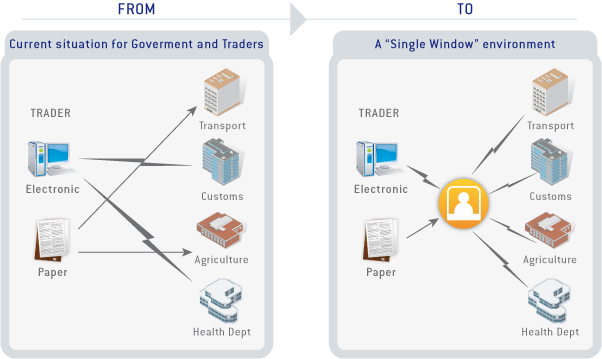Step 1. Learn what a Single Window is and what are the benefits of a Single Window for trade.
The Single Window concept
What is a Single Window
The term Single Window is being used to describe a multitude of different platforms, systems and environments, and the use is not limited to the trade context.
The most commonly accepted definition of a SW is the one provided by UNECE Recommendation No. 33. It describes the SW as “a facility that allows parties involved in trade and transport to lodge standardized information and documents with a single entry point to fulfill all import, export, and transit-related regulatory requirements.” “If information is electronic, then individual data elements should only be submitted once”.

The common theme of these developments is that a Single Window is set up to allow the exchange of information between traders and government agencies, and amongst government agencies, for trade relevant procedures such as obtaining permits and licenses, certificates and necessary approvals, customs clearance, and port exit.
Single Windows offer a single point of entry and single submission of trade relevant data for traders, and a more efficient and faster processing in a paperless environment.
Experts recommend using the term Single Window only when the platform:
- Necessarily implies a data exchange between government authorities and economic operators, namely traders,
- If it supports regulatory requirements and formalities;
- Has been mandated by the government to perform these trade and transport regulatory functions. (*)
Single Windows as a trade facilitation tool
A Single Window can be an important trade facilitation tool. The WTO Trade Facilitation Agreement encourages all its members to set up a Single Window. (Article 10.4). The International Chamber of Commerce Custom Guidelines 2012 also support the use of a national Single Window and the WCO developed guidelines on how to set up a Single Window.
If implemented effectively, a Single Window project can achieve the following benefits.
- For the government as a whole: increase in government revenue, enhanced compliance with rules, improved efficiency in resource allocation, better trade statistics,
- For economic operators, such as traders: faster clearance times, a more transparent and predictable process and less bureaucracy,
- For an administration such as Customs: improved staff productivity through the upgraded infrastructure, increase in customs revenue, a more structured and controlled working environment, and enhanced professionalism,
- For the national economy as a whole: improved transparency and governance and reduced corruption, due to fewer opportunities for physical interaction.
The Korea customs service estimates that the introduction of its Single Window brought some 18 million USD in benefits in 2010, part of the overall economic benefit that year of up to 3.47 billion USD from the agency trade facilitation efforts. In Singapore, the national Single Window for trade called TradeNet, brings together more than 35 border agencies since 1989 and leads to big gains in government productivity. Singapore customs claims that for every 1 USD earned in customs, it spends 1 cent – a profit margin of 9,900%(*).
(*) See ECE/TRADE/C/CEFACT/2017/10
(*) World Bank, “Trading Across Borders”, in Doing Business report 2012 (World Bank 2012). Available from
http://www.doingbusiness.org/reports/global-reports/~/media/WBG/DoingBusiness/Documents/Annual-Reports/English/DB12-Chapters/Trading-Across-Borders.pdf
(*) (UNNeXT 2012).
